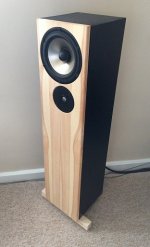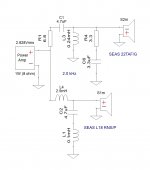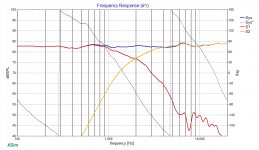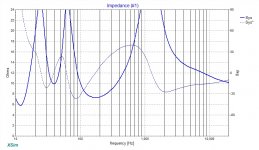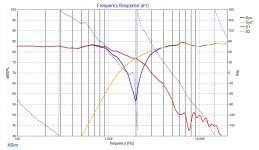GM, could a driver be attached to a baffle such that it is elevated from the baffle (with short tubing) to form a reflex slot at/behind the driver? Slot is bound by the drivers' back and the baffles' face.
Yes, it's a reflex variation of the '50s R-J 4th order BP [though not marketed as such] and still used by Supravox:
http://downloads.bbc.co.uk/rd/pubs/reports/1955-08.pdf
Subwoofer RJ Archives - Supravox
FWIW, when appropriate, I've posted about 'gapping' the driver from the baffle to lower system Q [sysQ] like the late horn designer Bruce Edgar did with a high Qt sealed back mid driver horn.
GM
http://downloads.bbc.co.uk/rd/pubs/reports/1955-08.pdf
Subwoofer RJ Archives - Supravox
FWIW, when appropriate, I've posted about 'gapping' the driver from the baffle to lower system Q [sysQ] like the late horn designer Bruce Edgar did with a high Qt sealed back mid driver horn.
GM
Here's some historical information!GM, could a driver be attached to a baffle such that it is elevated from the baffle (with short tubing) to form a reflex slot at/behind the driver? Slot is bound by the drivers' back and the baffles' face.
In the 5th edition of his book 'Loudspeakers', published in 1958, Gilbert Briggs suggested that spacing the driver a short distance from the baffle got rid of the worst effects of mounting a speaker in a small enclosure, and avoided a sharp rise in resonance frequency.
He went on to say that the driver may be spaced 1/8" or 1/4" away from the baffle - the lower the the cone resonance, the less the spacing required.
He did point out though, that this spacing arrangement was a replacement for a tuned vent.
I've also tried having the port on top of the enclosure, ie "ceiling firing". In some rooms that sounds more impressive than a floor firing port. And there's usually less clutter in the ceiling.
Many ways to make a small speaker sound "impressive", but down firing (or up firing) ports do often cause a somewhat "disconnected" kind of sound IMO. Like having a somewhat poorly integrated subwoofer. Seemingly impressive at first, but slightly muddy if you know your test music well and what to listen for.
Many ways to make a small speaker sound "impressive", but down firing (or up firing) ports do often cause a somewhat "disconnected" kind of sound IMO. Like having a somewhat poorly integrated subwoofer. Seemingly impressive at first, but slightly muddy if you know your test music well and what to listen for.
I'm interested in your thinking behind that arrangement.
Remember that low bass frequencies tend to be omnidirectional.
For example, a port on the front of the enclosure will radiate bass frequencies equally in all directions.
Provided a port is not hard up against a boundary such as the floor or rear wall, it will radiate bass frequencies equally in all directions.
If you are trying to ensure omnidirectional bass by employing the four ports as stated, then that is not necessary.
the idea was nothing fancy, just to simulate a true downfired port. my cabinets are already built and i can not put a port downwards, if i do then my tweeters gets to high up from the floor. i thought also four small ports would be better the one large.
At the risk of disagreeing with many others here...
If you're making a relatively small speaker, it should not matter much where you put the port.
But if you're making a narrow tower type speaker, then the modes triggered by a long rectangular type volume will in most cases interfere significantly no matter where you put them. If you have several small woofers, it is better to make a smaller volume for each, to shift internal modes to a higher frequency where they can be dealt with.
And unless you are very careful where you put the port, but only rely on crude calculations, you'd benefit from putting the port on the back or towards the floor.
I've tried enclosures with several distributed ports, better to just have them front OR back than on any sides IMO.
Lastly, front ports can be excellent (I'm addicted to properly designed front port enclosures, this is my first time talking in any SA (stereo addicts) meeting...), but they require a certain level of "attention to detail" to get right.
i really do not understand the difference between a mltl and a plain vented box, what is the sound / response difference? is it visable in a impedance plot?
The pictures below show the internals and externals. The port tube comes up the centre and is surrounded by BAF wadding. This seems to work fine. There are no standing waves and the bass output is unaffected.
that looks very nice! 🙂 If you did not used the midrange driver, do you think that you would ever hear any midrange freq coming from the port?
If you place it too low the speaker might become a MLTL. Just to keep in mind.
I like mine downfiring, works best. Just in case, keep in mind the area from the port to the free space does not add to port length unless you rise the speaker very slightly. The standard spikes sold by most vendors will rise it too much so do not hope for shorter port due to floor extension.
please tell some what the difference is between mltl and a plain vented box, are all tall and narrow vented boxes mltl? if i mount the port near the midwoofer is it still an mltl?
You're welcome!
Well, at 1/4 it's still ~ same as top WRT damping requirements whereas further down at an odd harmonic [dip] much less is required.
BTW, forgot to mention that due to having a vent, the actual distance is shifted around a bit, so for a minor extra bit of accuracy [less damping required] L * ~0.349, 0.42, 0.7, 0.848 for odd and ~0.21 for the only even harmonic commonly used.
Depends on the material's acoustic properties, desired amount of damping.
During my active building 'career', 'rigid' acoustic fiberglass duct board and/or in wall, ceiling batting insulation was the norm [at least in the USA], so with my big and/or tall cabs I just lined some portion of the top, back and one side of any parallel walls.
For the very high aspect ratio pipes like common today due to drivers having much stiffer suspensions [lower Vas], lower Fs [lower box tuning] combined with folk's general aversion to the health risks of FB; loose stuffing is the norm, which usually requires being held in place with some form of netting such as cheesecloth, so can be concentrated around the driver where it's most effective overall.
FWIW, early on I chose to defy the then ~universal 'standard' of removable backs to removable front 'sub' driver, vent baffles simply because the cabs were heavy and often were placed such that they had to be moved out into the room and/or the drivers needed to be rotated periodically due to the cloth surround's sealant melting down, 'weeping' onto the mounting gasket, diaphragm, not to mention some of these now long time vintage drivers are very heavy, unwieldy, especially when moving them around in the vertical plane!
Easier overall IME to hang onto/prop up a square or rectangular baffle than a loose driver that's only a flange mount's width wider.
Regardless, IME best to have a solid cab construction with one or more removable 'sub' baffles, which will make for at least as stiff/massive [or even greater] baffle than a one piece panel and Velcro on a nice false fascia or covered grill to hide all the mounting hardware/whatever.
GM
thank you, what would you rec'd as port placement for a 1 meter tall box, i use 2" fiberglass at top, bottom and on to the back?
that looks very nice! 🙂 If you did not used the midrange driver, do you think that you would ever hear any midrange freq coming from the port?
No. They were originally two way. Never had any problems.
Attachments
I've also tried having the port on top of the enclosure, ie "ceiling firing". In some rooms that sounds more impressive than a floor firing port. And there's usually less clutter in the ceiling.
Many ways to make a small speaker sound "impressive", but down firing (or up firing) ports do often cause a somewhat "disconnected" kind of sound IMO. Like having a somewhat poorly integrated subwoofer. Seemingly impressive at first, but slightly muddy if you know your test music well and what to listen for.
interesting, does that mean that you do not think there is any advantages with downfiring port with regards to in room response and setup?
In the 5th edition of his book 'Loudspeakers', published in 1958, Gilbert Briggs........
Right! Thanks for the reminder! This is one of the links I wanted to post, but couldn't remember the author and didn't find it Googling. New search shows no e-book still available. 🙁
GM
No. They were originally two way. Never had any problems.
that is good to hear, thank you 🙂
Btw, do you have a impedance graph also?
that is good to hear, thank you 🙂
Btw, do you have a impedance graph also?
Here's everything I have for that speaker. It's an old design now and the three way is much better. It sounded good though.
Attachments
In 99% of the cases, a MLTL would be better/properly calculated/simulated 😀 /end of difference.i really do not understand the difference between a mltl and a plain vented box
That would depend on choices/compromises made by the designer in each and every case. You decide yourself, during the design phase, where and how it should roll off.what is the sound / response difference? is it visable in a impedance plot?
Just saying that all that "impressive awesomeness sprinkled with fairy dust and edible unicorn poop" comes at a price. I'm personally not a big fan of fairy dust and unicorn whatever. In my opinion: To increase room coupling by willful design, is completely ridiculous. It can be hard enough to battle room modes with a closed box speaker, and designing a bass reflex type design with sharp roll-off and placing the port just like so to make it sound even bigger and more impressive, is merely effective use of smoke and mirrors.interesting, does that mean that you do not think there is any advantages with downfiring port with regards to in room response and setup?
No wonder bass reflex has such a poor reputation.
Depends............My 'knee jerk' response is to put it down the baffle at L [i.d.] x 0.848 based on the assumption that it's a small, high aspect ratio tower/column type cab [aka MLTL] and remove all damping in the bottom quarter and put it on one side at least in the driver area.thank you, what would you rec'd as port placement for a 1 meter tall box, i use 2" fiberglass at top, bottom and on to the back?
If not, then the cab's width, depth, driver brand/model, baffle offset, vent tuning, size/length, floor type & any coverings, location to any wall
GM
Here's everything I have for that speaker. It's an old design now and the three way is much better. It sounded good though.
wow, that impedance curve looks very clean and free from any wrinkles, very good behavior 🙂
In 99% of the cases, a MLTL would be better/properly calculated/simulated 😀 /end of difference.
That would depend on choices/compromises made by the designer in each and every case. You decide yourself, during the design phase, where and how it should roll off.
Just saying that all that "impressive awesomeness sprinkled with fairy dust and edible unicorn poop" comes at a price. I'm personally not a big fan of fairy dust and unicorn whatever. In my opinion: To increase room coupling by willful design, is completely ridiculous. It can be hard enough to battle room modes with a closed box speaker, and designing a bass reflex type design with sharp roll-off and placing the port just like so to make it sound even bigger and more impressive, is merely effective use of smoke and mirrors.
No wonder bass reflex has such a poor reputation.
none of my softwares can simulate mltl's so i am forced to do guess work here and testing and it is not very efficient. i guess you can optimize an mltl, just as for a bassreflex, to have a very shallow rolloff that is a better match to the room gain then any sealed box
if mltl works differently then a plain bassreflex then this should be seened in a impedance plot, right?
Depends............My 'knee jerk' response is to put it down the baffle at L [i.d.] x 0.848 based on the assumption that it's a small, high aspect ratio tower/column type cab [aka MLTL] and remove all damping in the bottom quarter and put it on one side at least in the driver area.
If not, then the cab's width, depth, driver brand/model, baffle offset, vent tuning, size/length, floor type & any coverings, location to any wall, corner can have an impact on it to a greater or lesser extent as for all I [don't] know right now it might be best overall in the top rear in one of the floor/ceiling's odd harmonics.
GM
damn it! i just glued the baffle to the enclosure and i can not longer pull out damping material from the bottom, well, live and learn 🙂
But for the experiment, i did mount three ports on the baffle, one close to the floor, one close to the midwoofer and the third one in the middle, in this way i can try each and listen to which ones sounds best, are all together
none of my softwares can simulate mltl's so i am forced to do guess work here and testing and it is not very efficient. i guess you can optimize an mltl, just as for a bassreflex, to have a very shallow rolloff that is a better match to the room gain then any sealed box
if mltl works differently then a plain bassreflex then this should be seened in a impedance plot, right?
Seems to me you believe "room gain" is some kind of fixed and relatively predictable thing, which would be slightly closer to truth if you had no ceiling, or rear walls.
Hold that thought, and let me introduce you to it's cousin: "in-room nulls caused by phase disturbances from reflections".
I do not reach many of the more experienced people here up to the kneecaps, but gain and loss frequently come in equal measure.
You achieve gain from limiting sound radiating into space, but you also achieve disturbances from limiting the sound radiating into space.
Any vented enclosure, by and large, works more or less the same way, merely some differences in the approach. You have some form of resonance forming at the end of some duct or port attached to a chamber or whatever else. This resonance works against the movement of the speakers membrane, controlling cone movement and causing it to stand nearly still, while the port or end of duct/horn/whatever takes over and dominates the sound output.
You're having fun doing some experiments without regard for the theory involved. This can be a fun experience, and it is nice to be able to ignore theory and just dive into some task. However, I think you'll find that if you do try to apply proper theory, and properly simulate a design before you build it, you are more prone to succeed.
- Home
- Loudspeakers
- Multi-Way
- Best port location?
